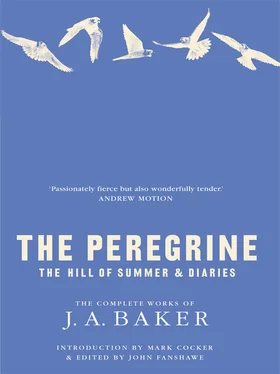No other predator conflicts with the peregrine in the pursuit of prey, but it is sometimes prevented from hunting in certain places by the determined and concerted attacks of crows. When man is hunting, the peregrine goes elsewhere. It is remarkably quick to distinguish between an unarmed man and a man with a gun. There is a curious relationship between peregrines and kestrels that is difficult to define. The two species are often seen in the same place, especially in autumn and spring. I rarely saw one of them without finding the other close by. They may share the same bathing places, the peregrine may occasionally rob the kestrel of its prey, the kestrel may feed on kills the peregrine has left, the peregrine may attack birds that the kestrel unwittingly puts up for him. In September and October some peregrines seem to copy the kestrel’s way of hunting, and I have seen the two species hovering together over the same field. In a similar way, I have seen a peregrine hunting near a short-eared owl, and apparently mimicking its style of flight. By March the relationship between kestrel and peregrine has changed; the peregrine has become hostile, and will stoop at, and probably kill, any kestrel hovering near him.
During ten winters I found 619 peregrine kills. Individual species were represented as follows:
Woodpigeon
38%
Black-headed gull
14%
Lapwing
6%
Wigeon
3%
Partridge
3%
Fieldfare
3%
Moorhen
2%
Curlew
2%
Golden plover
2%
Rook
2%
In addition to these ten, there were 35 other species taken, to make up the remaining 25% of the total. Analysed by families, these are the proportions:
Pigeons
39%
Gulls
17%
Waders
16%
Duck
8%
Game
5%
Corvids
5%
Small or medium-sized Passerines
5%
Others
5%
More woodpigeons were killed during the winter I have described in this book, because of their extraordinary abundance in the cold weather, and because of the absence of other inland species at that time. The relative figures for this particular winter are as follows:
Woodpigeon
54%
Black-headed gull
9%
Lapwing
7%
Wigeon
3%
Partridge
3%
Fieldfare
2%
Moorhen
2%
Curlew
2%
Rook
2%
Mallard
2%
The remaining 14% was made up of 22 other species.
These tables suggest that the juvenile peregrine preys mainly on those species that are most numerous in its hunting territory, provided they weigh at least half a pound. Sparrows and starlings are very common here, but few are killed by peregrines. Of the larger birds, the commonest and most widely distributed species are woodpigeons, black-headed gulls, and lapwings, in that order. If the total weight of available prey is considered, the woodpigeon probably represents a proportion of the total biomass approximately equal to the percentage of woodpigeons actually killed by the peregrine. The method of selection employed, if there is one, may in fact be nothing more spectacular than this: that the peregrine kills most frequently the species of bird it sees most frequently, provided it is a reasonably large and conspicuous one. The presence of abnormally large numbers of any species of bird invariably results in a higher proportion of that species being killed by the peregrine. If a dry summer enables more partridges to breed successfully, then more partridges will be taken by the peregrine during the following winter. If wigeon numbers increase when the cold weather comes, more wigeon will be killed. Predators that kill what is commonest have the best chance for survival. Those that develop a preference for one species only are more likely to go hungry and to succumb to disease.
Over the valley and the estuary, many gulls and lapwings are killed by the peregrine in October and November, chiefly from freshly ploughed land. From December to February woodpigeons are the main prey, especially in hard weather, when fewer lapwings are available. Woodpigeons are still taken in March, the killing of lapwings and gulls increases again, and more duck are killed than in any other month. Game-birds, moorhens, fieldfares, and waders, are taken occasionally throughout the winter. In rain or fog, game-birds and moorhens become the principal prey. Ducks are killed far less often than is popularly supposed. This is true of all countries, both in summer and winter; the peregrine is definitely not a ‘duck-hawk’. Domestic and feral pigeons figure highly in most lists of peregrine kills, but I have found none here. No peregrine I have seen has ever attacked them, or shown any interest in them at all.
The peregrine’s choice of prey can be affected by weather conditions. When a wet summer is followed by a wet winter, the land becomes water-logged, ploughing is delayed, and the valley bathing-places are covered by flood-water. Peregrines then hunt over the grasslands to the south of the valley and between the two estuaries. They bathe in ditches or at the edge of flood-water. Some birds prefer to hunt over grassland, irrespective of weather conditions. These green-country peregrines arrive late in the autumn and stay till late April or early May. Possibly they come from the Lapland tundra, where the country, in summer, is like a huge emerald sponge. The wet marsh pastures, and the green fields of the heavy clay, are the colour of home to them. They range over vast distances, they fly high, they are much harder to find and follow than the comparatively sedentary peregrines of the valley. Lapwings, gulls, and fieldfares, feeding on worms in wet pastures, are their favourite prey. Clover-eating woodpigeons are taken from January to March. Nest-building rooks are often attacked.
It seems unlikely that the peregrine can have a discriminating sense of taste. If it has a preference for a certain species, it is probably because of the texture of the flesh and the amount of tender meat on the bones. Rooks, jackdaws, gulls, sawbill ducks and grebes, are all more or less distasteful to the human palate, but are eaten by the peregrine with apparent relish.
Conspicuousness of colour or pattern increases vulnerability and influences the peregrine’s choice of prey. Birds moving from place to place are always vulnerable, whether they are flying to and from their roosts along known ways, or merely passing over the territory on migration. Recent arrivals are attacked at once, before they can learn refuges. The odd are always singled out. The albinos, the sick, the deformed, the solitary, the imbecile, the senile, the very young; these are the most vulnerable.
Predators overcome their prey by the exploitation of weakness rather than by superior power. As in the following instances:
Woodpigeon
The white wing and neck feathers are visible at a great distance. White shows up against all ground-colours. The peregrine sees and reacts to white more rapidly than to any colour. Eight per cent of the birds killed in the territory were either mainly white or showed conspicuous white markings. Woodpigeons are also betrayed by the loud clatter of their wings at take-off. In spring, their display flight makes them still more obvious. Their flocks gain height too slowly, and the individual birds do not keep close enough together. They are strong in level flight; they are quick to see danger from below and to swerve suddenly aside; but when attacked from above, their reaction is less violent, they dodge with difficulty, their straight flight is slow to bend. Because they are so much shot at and disturbed by man they are often forced to fly beneath the hunting hawk. They are loose-feathered and easy to pluck. In every respect they are an ideal species for the peregrine to prey upon. They are noisy, conspicuous, numerous, heavy, well-fleshed, nourishing, and not hard to kill.
Читать дальше












